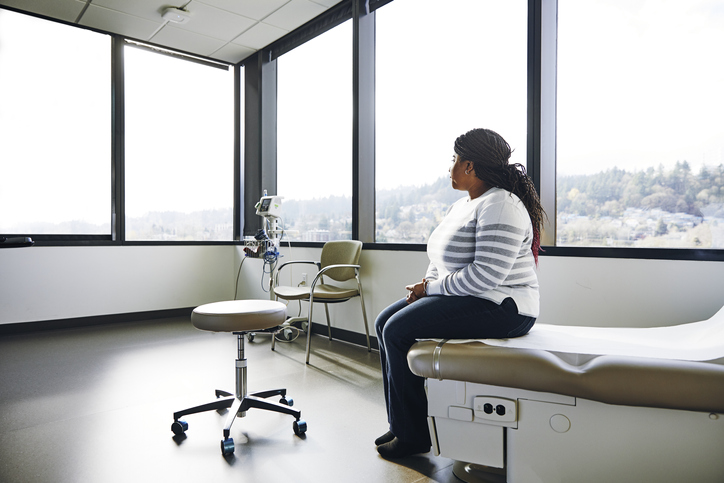
Source: The Good Brigade / Getty
Jessica Lumpkin, MBA
In July 2019, Milwaukee became the first city in the United States to declare racism a public health crisis. Two years later, dozens of other cities have followed suit as protests erupted all over the country in response to everyday racialized incidents of violence that led to the deaths of George Floyd, Breonna Taylor, Ahmaud Arbery, Tony McDade, and countless others.
In addition to being a serious social issue, racism is also a serious challenge to public health. It affects the wellbeing of people who are subject to racism in every way, including physically. In the state of Florida, there are significant health disparities between groups of different races, with some of the largest gaps being between white and Black people. It should be emphasized that these racial health disparities are not rooted in biology. All humans are over 99.9% genetically identical, and even those differences that are in the 0.01% are not determined by race. While people of different ancestry are occasionally predisposed to one comorbidity or another, study after study has refuted the notion that this could account in any way for the health disparities we see today.
Arguably, health disparities have everything to do with the type of racism that is built into the fabric of society through laws and structures that promote and sustain racial inequality. This is systemic racism. It is important to note that systems and structures of oppression can build upon each other to the point that they become hard to recognize, especially for the communities that benefit from them. This is often the case, even though in countries like the United States, they have been in place since the founding of the country.
Systemic racism leads to racial disparities in practically everything that impacts wellbeing, be it access to nutritious food, healthcare, or quality schools. It also leads to pervasive discrimination from law enforcement officers, clinicians, employers and others—many of whom have been trained and educated in racist systems. These outcomes can be seen in the disproportionate impacts of COVID-19, disproportionate unemployment rates, disproportionate rates of incarceration and wrongful conviction, disproportionate rates of infant mortality, disproportionate rates of individuals living at or below the poverty line, suffering from housing, transportation issues, and the list goes on.
Over the course of 2020, the COVID-19 outbreak magnified already existing barriers to health equity in communities of color. With Black Americans currently being hospitalized 2.9 times higher and dying from COVID-19 at rates 1.9 times higher than white Americans, one might assume that Black people would be lining up with zest to receive the vaccine as soon as it is available. However, access issues and mistrust rooted in structural racism appear to be the major factors inhibiting Black, Indigenous and other people of color from getting and taking the vaccine.
America has a terrible history of medical experimentation on Black Americans. So much so that the legacies of experimentation and racism date back to the origins of this country and are still quite fresh. For example, the United States’ first medical colleges purchased enslaved men to dig up freshly buried bodies from Black cemeteries to use for experiments and autopsies. This is just one example of injustice.
In 1932, the infamous Tuskegee Experiment began in which hundreds of Black men in Alabama went untreated for syphilis without their informed consent. This study is widely believed to have continued on into the early 1980s, but is documented as ending in 1972. In 1955, a secret military program called Operation Big Buzz tested the viability of deploying mosquitoes as a delivery system for biological warfare weapons. In doing so, swarms of thousands of mosquitoes were dropped on Carver Village, a Black neighborhood in Savannah, GA.
Given the historic demonstrations of violated public health mistrust in the Black American community, one may consider caution toward the COVID-19 vaccine a rational approach. “You would think that our country realized that testing different viruses and even potential war viruses on Black American communities was wrong and would have stopped many years ago,” said Jamie Ulmer, CEO at Heart of Florida Health Center, a Community Health Center in Marion County, FL. “And when you take into consideration that these types of experiments and studies were still happening in American society just a few decades ago, I understand, not only as a Black person but also empathize as a leader in community health as to why minority populations would be hesitant about taking the COVID-19 vaccine.”
“However,” Mr. Ulmer emphasized, “When I was still serving in the U.S. Army and was deployed to Desert Storm and Desert Shield in the early 1990s, I took ‘Vaccine A,’ which was still under trial at that time. It later became known as the vaccine for anthrax. As a young kid back then, I had to trust the system, trust the science and take the vaccine to protect myself. Today we are faced with that same dilemma with this virus.”
“Historic events of public health injustice are commonly passed down through generations of Black families at an early age, and rightfully so,” said Dr. Temple Robinson, CEO of Bond Community Health Center in Leon County, FL. “Even in 2021, we in medicine know that Black patients are less likely to receive pain medicine due to a culturally insensitive perception, or implicit bias regarding pain tolerance. Black women are more likely to be given a hysterectomy instead of other minimally invasive treatment options, and the list goes on.”
“Instead of these facts inhibiting me from taking the vaccine myself,” Dr. Robinson shared, “it prepared me to listen to members of my community, which is imperative— especially now as a community health leader. Further, it prepared me to educate individuals resistant to receiving the COVID vaccine with factual information and to encourage all people and especially minority populations who are more likely to die from this virus, to take the vaccine.” Dr. Robinson and Mr. Ulmer, both Black CEOs of their respective Community Health Centers have each taken both doses of the Moderna COVID-19 vaccine.
Overall, public health messaging has been seemingly slow to stop the spread of conspiracy theories and misinformation about the vaccine on social media. And of course, the choice of name for the vaccine development, “Operation Warp Speed,” did not help, leaving many feeling it was all done too fast.
“Often times when you are trying to present things to the community at a very fast pace, you skip some steps,” Mr. Ulmer said. “In this case, we should have intentionally been more proactive with outreach efforts explaining that the efficacy of the vaccine was not rushed. These vaccines have been studied since the 1990s—a very significant amount of time, and that is the exact reason it was able to be approved so quickly.”
“Let’s be honest,” Mr. Ulmer continued. “It is not an easy task to bring a new vaccine to the market. It costs billions of dollars and tremendous amounts of studies. The vaccine was already waiting for the opportunity for these drug companies to bring it into fruition. When the pandemic hit, the government assisted with funding, and there was a rapid accreditation and approval process. This trifecta created the perfect time for drug companies to bring the vaccines to the market.”
“In spite of common misconceptions, what did in fact happen that was extremely fast and brilliant, I might add, is that the science of the Messenger RNA (mRNA) was tailored to the virus and made in factories fast enough that within a year, it is available to the public and we are able to inoculate against COVID-19,” Dr. Robinson said. “This vaccine was fast, but it was not rushed. Those are two different things.”
When asked about her own experience taking the COVID vaccine, Dr. Robinson shared that, “My first reaction to the vaccine was a sore arm and nausea, but my arm was less sore than when I took the flu shot, and the nausea did not cause me to miss a meal. With the second dose, I still experienced soreness in the arm, the nausea was worse—still, I did not miss a meal. I had severe chills for about five hours, and those effects were the result of my body making an antibody response to the vaccine. When the sun came up the next day, I felt as if nothing had ever happened.”
“Beyond my own experience, I have found that older patients in their upper 70s, for example, are less likely to have a reaction to the injection,” Dr. Robinson continued. “Another common reaction is aches and pains, fever, headaches as well as swelling of the lymph nodes across the collar bone or under the arm where the shot is administered. Enough time has not passed to speak toward long-term effects; however, when looking at the science behind how the vaccine was made, one should note that the injection is not introducing any DNA or RNA into the body, and is not changing recipients’ DNA.”
“One out of every 645 Black people will die from COVID—that is why we have to take the vaccine,” Dr. Robinson maintained. “We must think practically and compare a few days of discomfort versus hospitalization, intubation, and ultimately untimely death from COVID-19. We should remember the past and hold both people and systems to account for the past; however, we should also reflect forward knowing that there were so many Black American scientists involved with the development and the trial of this vaccine. As a result of more than 10% of Black people of all ages, and 15-16% Hispanic people of all ages participating in the trial, both Moderna and Pfizer were approved by Black doctors and recommended by the National Medical Association.”
“In order to get to the place where we can reckon with the past and rebuild mistrust, we as community health leaders have to do things in a different way, we cannot just offer the vaccine,” Mr. Ulmer said. “It all starts with education and science, but the person sharing the information must be someone that speaks the same social and cultural language as the population that is trying to be reached.”
“I am from a historically Black college,” Mr. Ulmer added. “When I speak, people in my community listen because I am from there, grew up there and went to school there. They trust me because I would never do anything to hurt them. Why? Because these are my people, and that trust goes both ways. If you are a leader at a Community Health Center and you know that there have always been disparities in the Latino and Black communities, you have to be deliberate in developing a plan to ensure that the vaccines are accessible for disparaged populations. You have to be intentional while staying within the confines of the governor’s executive order and make a vested effort to hold 30% or whatever amount appropriate for your Center’s demographics to combat the vaccine distribution disparities we are facing.”
The concept of the COVID vaccine weighs heavily on Black Americans because staunchly, the one issue that remains a stain on the clothes of this country is racism and the domino effects of inequitable truths that inhibit people of color from experiencing life equally. Black people were once referred to as 3/5 of a man, and in 2021, we still see examples where American society has yet to uphold their lives and contributions as holding equal value. In realizing that systemic racism and implicit bias is still at play, be it within the constructs of public health or the judicial outcomes and consequences of an insurrection on the United States Capitol (an area built on the backs of enslaved Black men and women while serving as a public display of American freedom), attention can no longer be diverted, nor blame shifted.
From discriminatory treatments in systems, to the effect of stress on bodily cells—on every level, racism causes and perpetuates the massive health disparities in this country. This is why, after centuries of permeating bias, cities and counties all over the United States are now declaring systemic racism as a public health crisis. Today, we must look at the evidence and the outcomes, although we may have yet to have been born to see the origin. And in the words of the late Congressman and Civil Rights Activist John Lewis, we must get in “Good Trouble.”
Health equity is and always has been intertwined with the struggles for racial justice. We must purpose ourselves within our communities and profession to act by building systems that eliminate discriminatory barriers to health, disrupt harmful stereotypes, promote health equity, support people who may be experiencing difficult circumstances, and advocate for national and state healthcare systems to remedy the harms caused by health disparities.
Health equity is a moral imperative and basic human right. When future generations look back at this time in history and reflect on how we managed the challenges of this time, may we be remembered for having the uncomfortable conversations and taking action toward disparities that hit minority populations especially hard.
We all have different degrees of resources, ability, and influence. Use yours intentionally to build bridges across cultural lines and establish equity and equality for all.
“Get in good trouble, necessary trouble, and help redeem the soul of America.”
-The late Congressman & Civil Rights Activist John Lewis speaking atop The Edmund Pettus Bridge in, Selma, AL., March 2020.


